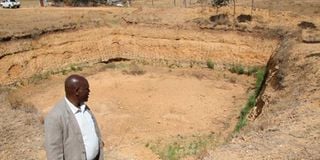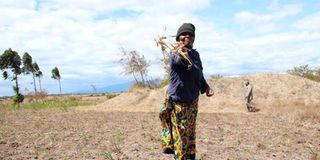Premium
Hunger stalks Solio villages in Laikipia as unutilized water pans remain dry

Maina Mugo stands in front of a dry water pan at Solio Settlement Scheme in Laikipia County. Farmers in the area have suffered heavy losses due to drought as they have had four seasons of crop failures in the last two years.
Despite the government sinking small dams and water pans worth millions of shillings in parts of Nyeri and Laikipia counties, residents are still grappling with drought due to water shortage five years on.
At the seven villages of Solio Settlement Scheme, the arable land has remained untilled for the last four years, as the farmers have not received sufficient rainfall. The area receives an average of 550mm rainfall per year.
The idea was to ensure the water pans collect enough water to enhance agriculture productivity that would end hunger cycles experienced in the area that leaves thousands of people relying on relief food.
But tens of these water resources have long dried up turning them into eyesores in the farmlands while those that were constructed along waterways and with enough water to irrigate crops for at least a season are too expensive for farmers to consider.
Ms Jane Waruguru, one of the beneficiaries of the individual water pans that were dug in her farm in 2017 by the National Irrigation Board (NIB) through the Ministry of Agriculture, says the water pan has only been utilized a few times. She used to grow beans, potatoes, cabbage and tomatoes for commercial and subsistence use.
The water pan measuring about 12ft by 30ft is currently being used for laundry purposes and to feed her domestic animals as she cannot afford to lease or buy hosepipes and a water pumping generator.
“We are torn between feeding our children and leasing these tools which are extremely expensive for us. More so, even if we lease we cannot manage to do so consistently which would not be financially viable,” she offered.
In this village alone, the NIB dug 28 dams and all are currently not in use. The water pans with some water are quickly depleting as they do not have liners to hold the water.
“It pains us to see all this water and we are not able to use it. It is just going to waste,” Ms Waruguru said.
The residents of Solio were migrated from Mathira during the late President Mwai Kibaki tenure from Mt Kenya forest where they were farming. Each of them was allocated at least four or five acres of land to cultivate. There are about 1, 500 people in each village.
Pumping water in the farm between morning and evening from their water pan costs about Sh500 when a farmer has their own hosepipes. They are also supposed to buy fuel which is about three litres per round of irrigation.

Jane Waruguru at her farm where crops have dried up due to drought at Solio Settlement Scheme in Laikipia County.
Without the hosepipes, a farmer is supposed to lease them at Sh100 per pipe depending on the distance between the water pan and the farm. Sometimes it takes about seven hosepipes.
Ms Waruguru says she cannot afford the tools thus derailing her plans to grow crops even for subsistence purposes.
“My husband and I rely on casual work and for a whole week we have not gotten any jobs. The little we get we eat and keep our children in school thus forfeiting farming in our own shamba,” she said.
The casual work involves tilling other people’s farms in parts of Nyeri for Sh300 a day.
“Once we are paid, we buy maize flour for a meal a night and the remainder is used to cook porridge for the children,” she added.
Solio sits between Nyeri and Laikipia, and experts opine that with enough water for irrigation, the seven villages can produce enough food to feed their population and neighbouring counties.
Dozens of people in the villages replicate Ms Warugugu’s story noting that the government should have equipped them with all tools to facilitate complete cycles of irrigation.
“The dams cannot hold water for long because they do not have a liner hence the water always gets sapped by the soils quick. They [the government] should have also provided us with water pumps and hosepipes,” said Mr Charles Ngunyi.
Despite the agricultural potential in the area, the farmers rely on relief food and purchasing food items in other counties.
“This was just an election promise that was never followed through to completion because despite the water pans we are still in need of aid as we are not food secure,” he added.
But according to NIB, it was the farmers’ responsibility to repair the dams or water pans and put in place necessary irrigation equipment in order to utilize the water efficiently as they were only mandated to provide funds for excavation and construction of the water pans.
In 2019, then Cabinet Secretary Mwangi Kiunjuri said the government was sinking 31 community water pans in different parts of the country with an average size of 100, 000 cubic metres at a cost of Sh450 million.
At least 4, 000 community dams that were constructed during the colonial era were to be rehabilitated by the NIB at an average of Sh150 per cubic metre.
Further, the farmers were obligated to agree to provide a site or land suitable for water pan construction but they would be responsible to carry out soil and water conservation measures if required once the water pans were constructed.
Farmers were also expected to fence off around the water pans to prevent destruction or trespass to the water pans – a measure that most farmers have not adhered to. Most water pans visited by the Nation were gaping dangerous abysses.
The farmers were also supposed to guarantee that the water is put to beneficial agricultural use.
In addition, it is the farmers’ responsibility to ensure safety precautions are met and accept any liability that may arise after the completion of the construction works.





